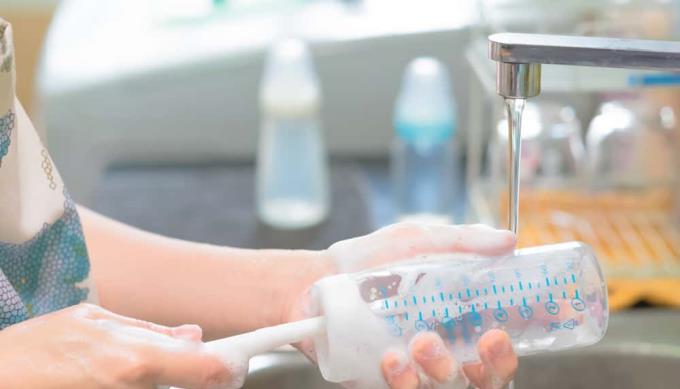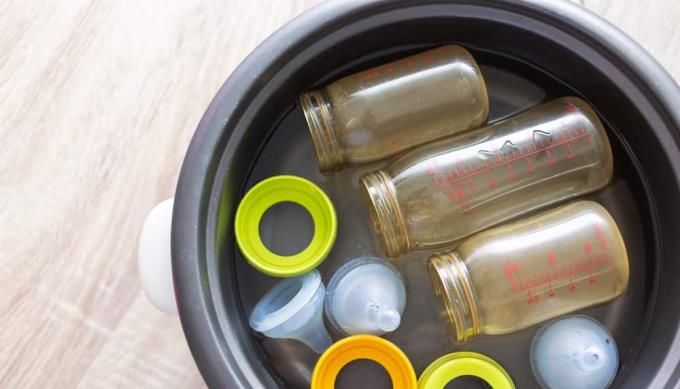Ways to determine an infants caloric needs

Learn how to determine your baby’s caloric needs, including the calories in breast milk and formula, to ensure your infant gets the right nutrition for healthy growth.
Bottle feeding has many benefits since anyone can breastfeed. However, if the bottle is not properly disinfected, your baby can get sick very easily. So, the problem of how to properly sanitize bottles is something you should learn when you want to let your baby use these items.
After your baby is born, breastfeeding is the best time to help you bond with your baby. However, after a few months, you should practice bottle feeding with expressed breast milk or formula so you can get back to work. As a result, you will need to sterilize the bottle before each feed to reduce your risk of infection. Below, aFamilyToday Health will give you some information about disinfecting baby bottles.
Certain microorganisms such as viruses, bacteria and fungi can accumulate in the bottle. Then, they will enter the baby's milk and enter the body, causing diarrhea , fungal infections ... So, you need to properly disinfect the bottle before feeding your baby.
You do not need to disinfect it immediately after each feed, as long as you rinse it off with hot water and store it in a clean container. It is a good idea to disinfect baby bottles from time to time. However, if your baby has a cold or the flu, you will need to disinfect it more often. Although the older the baby, the better the resistance, but you should continue to disinfect until your baby has completely weaned the bottle .
Conventional tap water can contain harmful chemicals. Therefore, you should use filtered water for disinfection. Even if you are steam sterilizing, you should still use filtered water for hygiene.

Before disinfecting, rinse the bottle, nipples and scoop with warm water and bottle cleaning solution. You can use the brush to clean the jar and its internal parts. When washing, rotate the brush to remove excess milk or milk powder from the bottle.
Clean any remaining milk on any parts of the bottle, including the lid. Remove the nipple to wash. Rinse right after your baby is done feeding to avoid fermentation or dry excess milk that will make it harder to wash. After washing with water, wash it again with soap. Remember to wash your hands well before disinfecting baby bottles.
If you are feeding your baby plastic bottles, choose bottles made from high quality plastic that do not contain BPA. But don't forget to disinfect a new bottle before using it. If not, you can give your baby a glass bottle. Usually, without specific instructions, you can disinfect a glass bottle like a plastic bottle.
Regularly check the bottle and the teat for cracks or scratches. Bacteria often tend to accumulate in the cracks and persist even after washing and disinfecting them.
Use a clean cloth to dry your baby's bottle after disinfection. Store in a separate area and, if possible, keep it in a sealed container to keep out dust.
Only open the bottle before feeding your baby. After disinfection, always cover items to keep items from invading bacteria.
Wash your hands thoroughly with soap before handling the bottle after disinfection. You can also use tongs to take parts such as nipples, bottle caps ... and place them on a clean surface.
Do not leave sterilized bottles outside for too long. Place bottles in storage facilities and remove them before use. If you do not have the storage facilities, you should disinfect it if you do not use it for a long time.
There are many methods to disinfect baby bottles. Here are some of the most used methods:

This is the most common method of sterilizing bottles. This is quite simple, but you need to make sure the material is safe to boil.
Prepare a large pot with a lid, fill with water. Then, immerse the bottle and other parts. Ideally, you should set aside a pot for this job and not use it for other purposes such as cooking.
The parts of the flask should not touch the bottom of the pot as exposures to high temperatures for too long can damage the bottle. Glass bottles might break and plastic bottles might melt. Boil for about 5 minutes.
Cover the pot once you are finished using it.
The downside of this method is that the bottles will deteriorate faster than other sterilization methods.
This method requires an electric steam sterilizer. You will need to follow the manufacturer's instructions for this method of disinfection. This disinfection is usually completed within 12 minutes.
Fill the steamer with water, then add the bottle and other parts of the bottle.
Cover and let the steam escape for a few minutes.
The bottle will be completely sterile in about 6 hours if the lid is not opened.
The steam sterilizer can disinfect 6 bottles at once and has separate nipple areas. Place bottles and utensils face down for more effective cleaning.
This is an effective UV disinfection. You will need to take apart the bottle parts and leave it in the microwave for about 90 seconds. This is a very fast method of disinfection. Before you do this, however, you need to make sure your microwave is clean.
Fill each baby's bottle with water. However, you only pour half a jar.
Microwave the bottle.
Place the nipples and other parts in a microwave safe bowl that has been filled with water.
Leave on for about 1.5 minutes.
Note: Wait a while before taking the bottle and teat out of the microwave to avoid burns.
Learn how to determine your baby’s caloric needs, including the calories in breast milk and formula, to ensure your infant gets the right nutrition for healthy growth.
Discover the top 5 smartest dog breeds in the world, including Border Collie, Poodle, German Shepherd, Golden Retriever, and Doberman Pinscher. Learn about their unique traits and why they are considered the most intelligent dogs.
Discover 7 nutritious and delicious ways to cook egg porridge for babies, including recipes with cheese, pumpkin, tomato, and more. Learn how to prepare baby-friendly egg porridge with our expert tips.
After a series of medical measures they obtained a complete human vascular system profile.
Watermelon is one of the fruits that many people love, not only cheap but also delicious, nutritious and refreshing in the summer. To get delicious watermelon pieces, show off your housewives, your artistic talents to cut beautiful pieces of watermelon.
aFamilyToday Health - The digestive system and body in each baby is different. Parents need to recognize notes to deal with when babies have a food allergy!
Babies need many factors for perfect development. aFamilyToday Health shares with parents things to keep in mind when babies are 8 weeks old so that parents can take care of their babies the best!
Babies need many factors for perfect development. aFamilyToday Health shares with parents things to keep in mind when babies are 18 weeks so that parents can take care of their babies the best!
Babies need many factors for perfect development. aFamilyToday Health shares with parents things to keep in mind when babies are 28 weeks old so that parents can take care of their babies the best!
Babies need many factors for perfect development. aFamilyToday Health shares with parents things to keep in mind when babies are 32 weeks old so that parents can take care of their babies the best!








